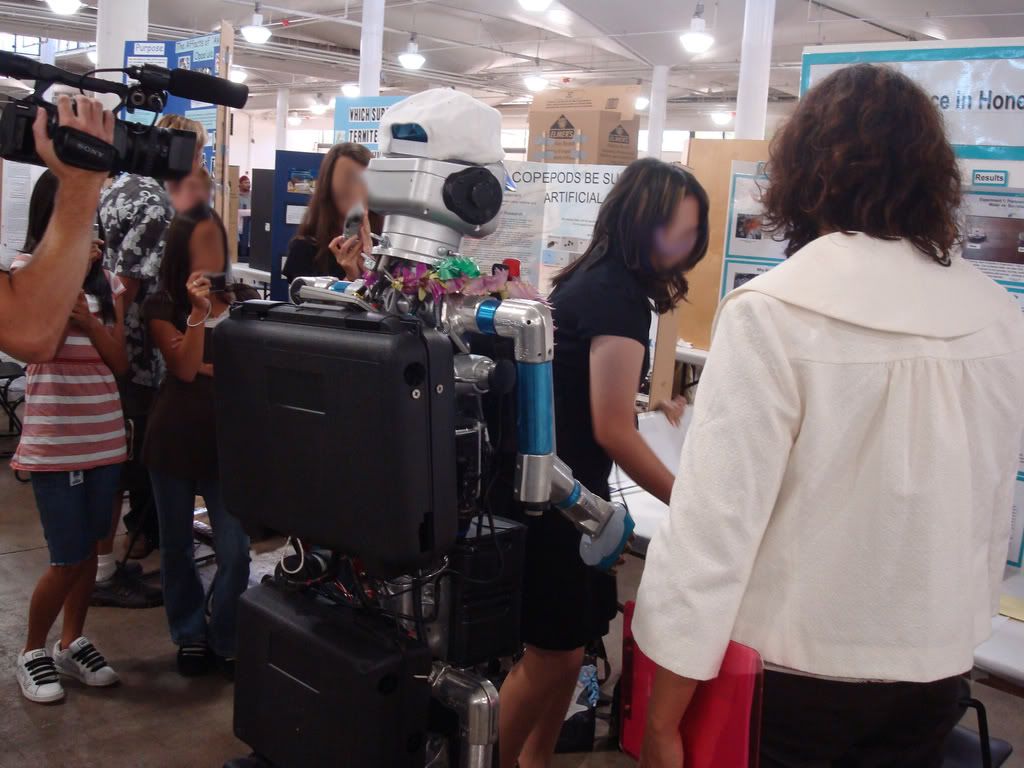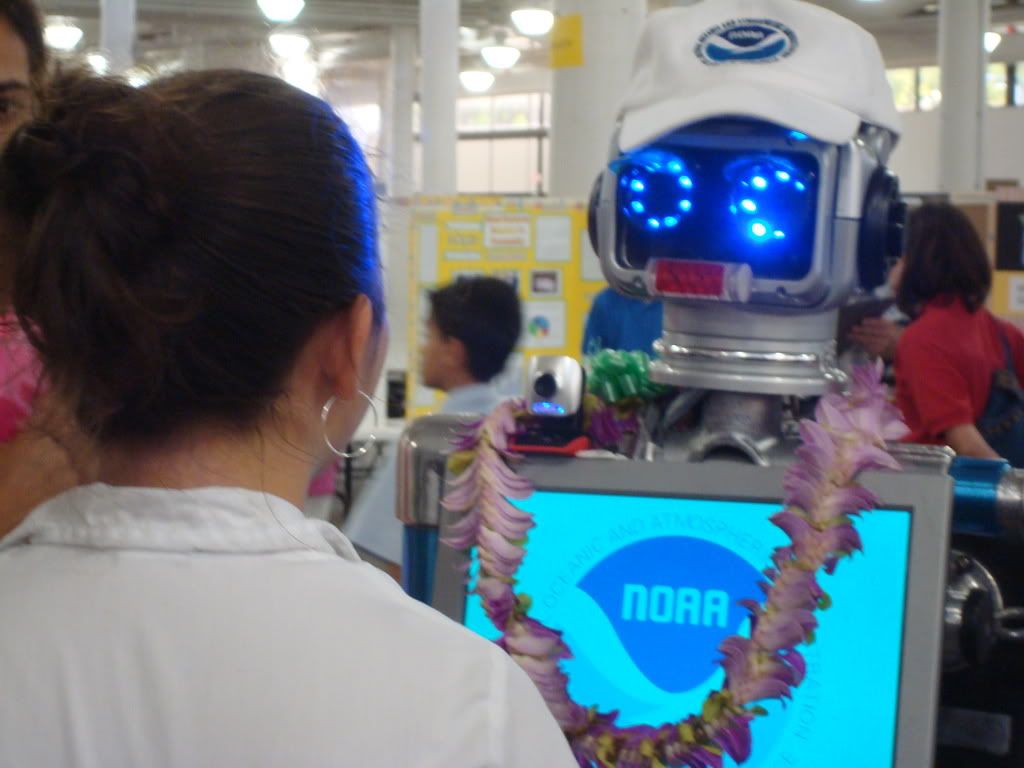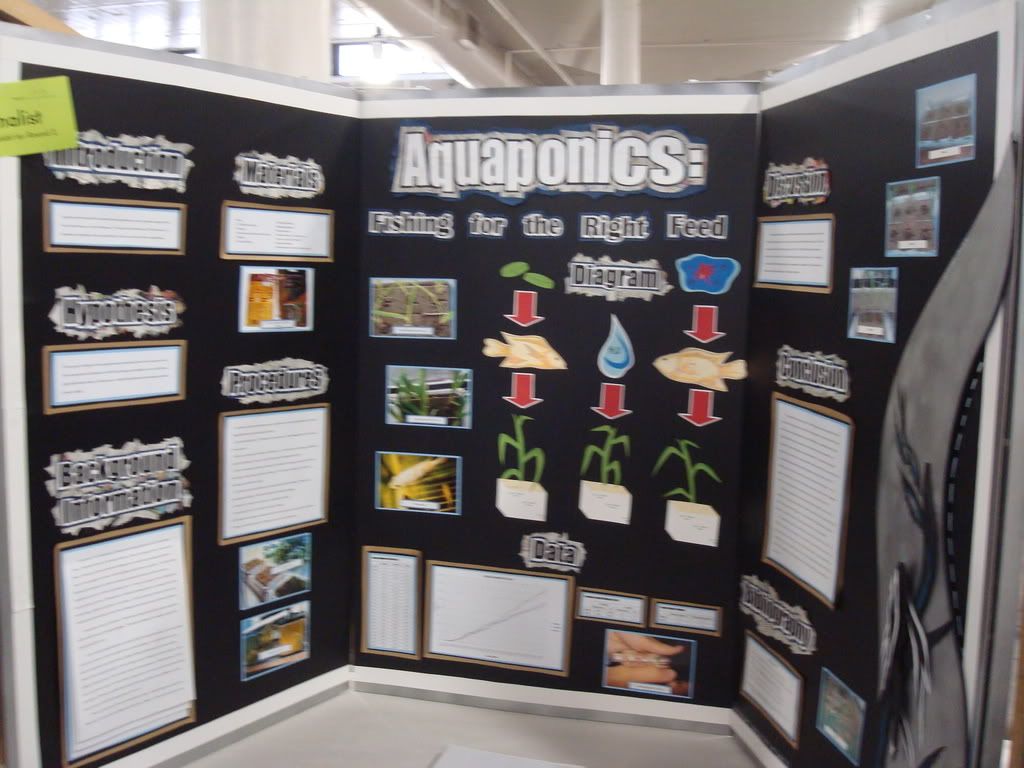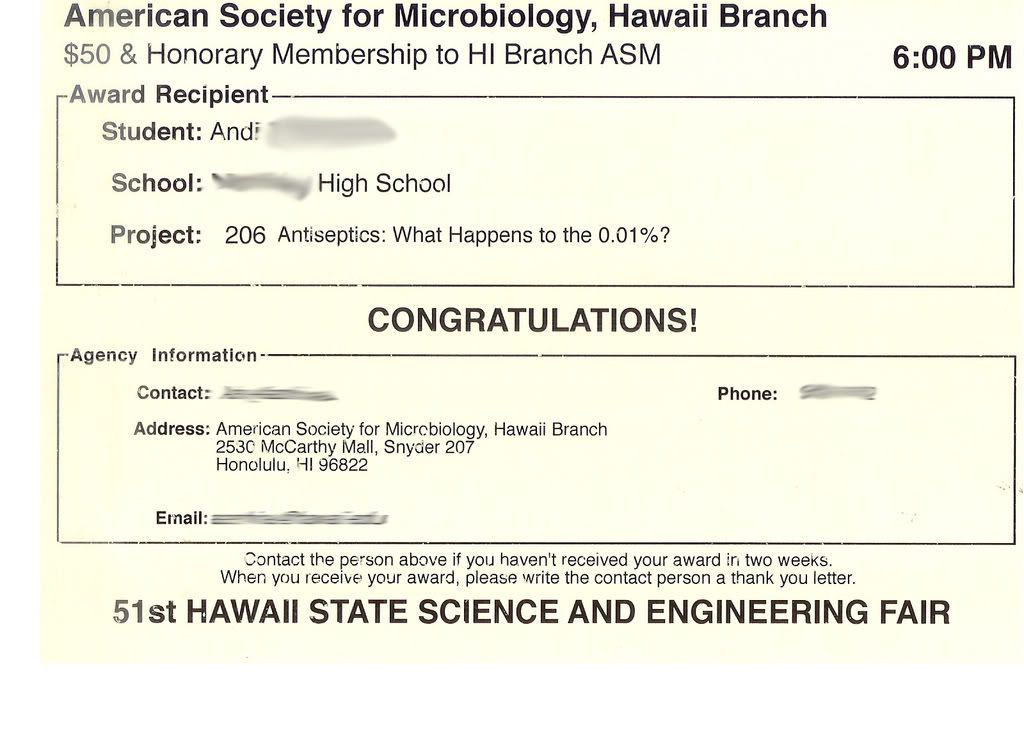Bacteria cultures in petri dishes
Moderators: AmyCowen, kgudger, bfinio, MadelineB, Moderators
-
donnahardy2
- Former Expert
- Posts: 2671
- Joined: Mon Nov 14, 2005 12:45 pm
Re: Bacteria cultures in petri dishes
Hi Andi,
I just called Germ-X and talked to Roslyn, who was the same person that you talked to, and I received the same replies (proprietary information) that you received. However, I did get a little information. The protocols used for testing Germ-X are specified by the FDA, and available from the FDA. I asked to speak with a company microbiologist, explaining that I am trying to advise you on a science fair project, and I needed some more information. The R & D group at Germ-X did respond to Roslyn and told her to send me the file from FDA, and she is going to FAX it to me. I'll forward it to you as soon as I receive it.
Donna
I just called Germ-X and talked to Roslyn, who was the same person that you talked to, and I received the same replies (proprietary information) that you received. However, I did get a little information. The protocols used for testing Germ-X are specified by the FDA, and available from the FDA. I asked to speak with a company microbiologist, explaining that I am trying to advise you on a science fair project, and I needed some more information. The R & D group at Germ-X did respond to Roslyn and told her to send me the file from FDA, and she is going to FAX it to me. I'll forward it to you as soon as I receive it.
Donna
-
procrastinationking
- Posts: 27
- Joined: Sat Jan 12, 2008 4:51 pm
- Occupation: Student
- Project Question: If there are cultures already growing in a petri dish, when a disinfectant solution is poured in, when the cultures die will they disappear?
- Project Due Date: 3/31/08
- Project Status: I am finished with my experiment and analyzing the data
Re: Bacteria cultures in petri dishes
Thank you so much! Wow, when I asked for help I had no idea you were going to call them on your own. "Wow", that's all I have to say. And "thank you" so, so much.
Wow and thank you,
Andi
Wow and thank you,
Andi
-
donnahardy2
- Former Expert
- Posts: 2671
- Joined: Mon Nov 14, 2005 12:45 pm
Re: Bacteria cultures in petri dishes
Hi Andi,
You are welcome. I just wanted to see if a request from a different source would help get more information, and I confirmed that the company will not share the information you need. Rosalind finally (very politely) told me that she could not give me any more information, so it's time to give up.
The problem is that Germ-X has been approved by the FDA for use on human hands only. The company has obviously complied with all of FDA's rules for making this product claim, and they have filed these results with the FDA, but unfortunately the company will not share any of the details. And, since they didn't test the product on counter tops or other surfaces, they cannot make any other statements about the use of the product other than on human hands. They cannot even recommend for use on feet because they did not do this testing. This is a legal issue because companies have to be very careful about making product claims that are regulated by the FDA.
For your science fair project, if the judges ask you about the apparent discrepancy, you can explain that Germ-X tested the product on human hands only with an unknown protocol and unknown microorganisms; you tested the product on counter surfaces using the procedures you have described. Scientifically, if researchers don't use exactly the same protocol, then results would not necessarily be expected to be the same. However, 70% ethanol is a standard solution used to sterilize surfaces (with a one hour exposure time), and is accepted for this use by the FDA, so I don't understand why the Germ-X did not significantly reduce the bacterial count. Perhaps your current experiment will help resolve this issue.
You should now concentrate on completing your experiment and revising your board. Please let me know about the results of your second experiment. Hopefully they will be consistent with the first experiments.
Donna Hardy
You are welcome. I just wanted to see if a request from a different source would help get more information, and I confirmed that the company will not share the information you need. Rosalind finally (very politely) told me that she could not give me any more information, so it's time to give up.
The problem is that Germ-X has been approved by the FDA for use on human hands only. The company has obviously complied with all of FDA's rules for making this product claim, and they have filed these results with the FDA, but unfortunately the company will not share any of the details. And, since they didn't test the product on counter tops or other surfaces, they cannot make any other statements about the use of the product other than on human hands. They cannot even recommend for use on feet because they did not do this testing. This is a legal issue because companies have to be very careful about making product claims that are regulated by the FDA.
For your science fair project, if the judges ask you about the apparent discrepancy, you can explain that Germ-X tested the product on human hands only with an unknown protocol and unknown microorganisms; you tested the product on counter surfaces using the procedures you have described. Scientifically, if researchers don't use exactly the same protocol, then results would not necessarily be expected to be the same. However, 70% ethanol is a standard solution used to sterilize surfaces (with a one hour exposure time), and is accepted for this use by the FDA, so I don't understand why the Germ-X did not significantly reduce the bacterial count. Perhaps your current experiment will help resolve this issue.
You should now concentrate on completing your experiment and revising your board. Please let me know about the results of your second experiment. Hopefully they will be consistent with the first experiments.
Donna Hardy
-
procrastinationking
- Posts: 27
- Joined: Sat Jan 12, 2008 4:51 pm
- Occupation: Student
- Project Question: If there are cultures already growing in a petri dish, when a disinfectant solution is poured in, when the cultures die will they disappear?
- Project Due Date: 3/31/08
- Project Status: I am finished with my experiment and analyzing the data
Re: Bacteria cultures in petri dishes
Hi Donna,
That was expected of Germ-X, but thanks for verifying what happened. I'll be able to use it in my conclusion.
I have some new bad news (sure been getting a lot of that). Thanks to my stupidity again, my second experiment has gone horribly wrong. As usual, I assumed (I have to stop doing that) that 70% ethanol worked the same way as Germ-X (despite the obvious differences). So, since there wasn't really any directions for cleaning surfaces on the label (only external body), I put the isopropyl onto the surface for just 30 seconds. Since I did not know I had to expose the surface to alcohol for one hour until now, I was wondering why my results were messed up. There's the bad news. My results are messed up. I was having a bad feeling about my experiment since the beginning; bad start (not enough petri dishes and trials due to unavailability during spring break. Since there wasn't enough petri dishes, I could not duplicate my experiment and was only able to test isopropyl, not Germ-X again). My results are crazy and inconsistent (I don't even have 2 trials for some). Here they are...
# of Bacteria Before and After Treatment % of “Superbugs”
Before After Resistance
Dishes 1&2 225 91 40%
Dishes 1b&2b 27 11 41%
This was the area not cleaned often (same as last time). Only 2 trials...
# of Bacteria Before and After Treatment % of “Superbugs”
Before After Resistance
Dishes 3&4 TNTC 189
This was the teacher's desk. The before dish had way over 300 (too many tiny colonies). Not sure how to find resistance for it.
# of Bacteria Before and After Treatment % of “Superbugs”
Before After Resistance
Dishes 5&6 123 25 20%
This is the doorknob...
# of Bacteria Before and After Treatment % of “Superbugs”
Before After Resistance
Dishes 7&8 43 26 60%
Dishes 7b&8b 21 8 38%
This is the kitchen counter. I originally planned to have 2 trials for all the surfaces located in school. But since the teacher suddenly became unavailable, I had to do two trials at home so I wouldn't have wasted the petri dishes.
Since I messed up big, should I still use the results (is there a way to find resistance for the trial with the TNTC or count all the colonies)? Should I just use the dishes 1&2, 1b&2b, 7&8, and 7b&8b? Or should I regard it as a failed experiment since I did not go through the proper process to sterilize a surface?
I can only imagine your frustration. After helping out a kid with everything, you had every right to expect good results. Instead you got this.
Sorry...
Andi
P.S.
If you feel I don't deserve your help anymore, I'll understand.
That was expected of Germ-X, but thanks for verifying what happened. I'll be able to use it in my conclusion.
I have some new bad news (sure been getting a lot of that). Thanks to my stupidity again, my second experiment has gone horribly wrong. As usual, I assumed (I have to stop doing that) that 70% ethanol worked the same way as Germ-X (despite the obvious differences). So, since there wasn't really any directions for cleaning surfaces on the label (only external body), I put the isopropyl onto the surface for just 30 seconds. Since I did not know I had to expose the surface to alcohol for one hour until now, I was wondering why my results were messed up. There's the bad news. My results are messed up. I was having a bad feeling about my experiment since the beginning; bad start (not enough petri dishes and trials due to unavailability during spring break. Since there wasn't enough petri dishes, I could not duplicate my experiment and was only able to test isopropyl, not Germ-X again). My results are crazy and inconsistent (I don't even have 2 trials for some). Here they are...
# of Bacteria Before and After Treatment % of “Superbugs”
Before After Resistance
Dishes 1&2 225 91 40%
Dishes 1b&2b 27 11 41%
This was the area not cleaned often (same as last time). Only 2 trials...
# of Bacteria Before and After Treatment % of “Superbugs”
Before After Resistance
Dishes 3&4 TNTC 189
This was the teacher's desk. The before dish had way over 300 (too many tiny colonies). Not sure how to find resistance for it.
# of Bacteria Before and After Treatment % of “Superbugs”
Before After Resistance
Dishes 5&6 123 25 20%
This is the doorknob...
# of Bacteria Before and After Treatment % of “Superbugs”
Before After Resistance
Dishes 7&8 43 26 60%
Dishes 7b&8b 21 8 38%
This is the kitchen counter. I originally planned to have 2 trials for all the surfaces located in school. But since the teacher suddenly became unavailable, I had to do two trials at home so I wouldn't have wasted the petri dishes.
Since I messed up big, should I still use the results (is there a way to find resistance for the trial with the TNTC or count all the colonies)? Should I just use the dishes 1&2, 1b&2b, 7&8, and 7b&8b? Or should I regard it as a failed experiment since I did not go through the proper process to sterilize a surface?
I can only imagine your frustration. After helping out a kid with everything, you had every right to expect good results. Instead you got this.
Sorry...
Andi
P.S.
If you feel I don't deserve your help anymore, I'll understand.
-
donnahardy2
- Former Expert
- Posts: 2671
- Joined: Mon Nov 14, 2005 12:45 pm
Re: Bacteria cultures in petri dishes
Hi Andi,
I wish you could stop worrying so much! You didn't mess up at all. It sounds like you reproduced the experiment using isopropanol instead of Germ-X, and that your results are remarkably similar to the results you obtained with Germ-X. It’s a good thing you didn’t expose the surfaces for an hour, because that would have been changing your experimental design. What you wanted to do was reproduce your original experiments to show that your results were valid, and that’s what you did. The isopropanol gave similar results to the Germ-X. There were resistant bacteria located on all of the surfaces.
In a scientific experiment, you set up the experiment and measure the results. The results are whatever they turn out to be; results cannot be messed up.
I don’t think you mentioned doing a negative control. This would be a plate that was not inoculated and that would show that your agar was sterile before the experiment. Do not worry if you didn’t do this, but think about how you can explain this, just in case someone asked about it. You didn’t need a positive control, because your agar plates obviously supported bacterial growth quite well.
For the sample on the teachers desk, you can report the percentage of resistant bacteria as greater than 37% ((300-189) divided by 300).
I am attaching the information that Rosalind from Germ-X sent me in reply to my questions. You can see that the information does not address our questions at all.
Now, the judging is Tuesday, so just concentrate on finished your write up today, and go to bed early tonight. You can let me know if you have any last minute questions. Please relax and try to enjoy the experience. I’m sure you will do fine, and your project is great!
Donna
I wish you could stop worrying so much! You didn't mess up at all. It sounds like you reproduced the experiment using isopropanol instead of Germ-X, and that your results are remarkably similar to the results you obtained with Germ-X. It’s a good thing you didn’t expose the surfaces for an hour, because that would have been changing your experimental design. What you wanted to do was reproduce your original experiments to show that your results were valid, and that’s what you did. The isopropanol gave similar results to the Germ-X. There were resistant bacteria located on all of the surfaces.
In a scientific experiment, you set up the experiment and measure the results. The results are whatever they turn out to be; results cannot be messed up.
I don’t think you mentioned doing a negative control. This would be a plate that was not inoculated and that would show that your agar was sterile before the experiment. Do not worry if you didn’t do this, but think about how you can explain this, just in case someone asked about it. You didn’t need a positive control, because your agar plates obviously supported bacterial growth quite well.
For the sample on the teachers desk, you can report the percentage of resistant bacteria as greater than 37% ((300-189) divided by 300).
I am attaching the information that Rosalind from Germ-X sent me in reply to my questions. You can see that the information does not address our questions at all.
Now, the judging is Tuesday, so just concentrate on finished your write up today, and go to bed early tonight. You can let me know if you have any last minute questions. Please relax and try to enjoy the experience. I’m sure you will do fine, and your project is great!
Donna
- Attachments
-
- germ-x.pdf
- (47.26 KiB) Downloaded 415 times
-
procrastinationking
- Posts: 27
- Joined: Sat Jan 12, 2008 4:51 pm
- Occupation: Student
- Project Question: If there are cultures already growing in a petri dish, when a disinfectant solution is poured in, when the cultures die will they disappear?
- Project Due Date: 3/31/08
- Project Status: I am finished with my experiment and analyzing the data
Re: Bacteria cultures in petri dishes
So if the isopropanol gave similar results to Germ-X, can I conclude that maybe Germ-X would have killed more bacteria if I exposed the surface to it for one hour? Also, I can't seem to find any sites where they say to sterilize a surface you leave on the alcohol for 1 hour (they just say to wipe surfaces with alcohol). If possible, can you send me the site where you got it from? EDIT: or can I put this page's url into my bibliography and have you as the author?
How would I put in this experiment that tests isopropanol? Would I put it into my last step of my first experiment's procedure, or should I put "second experiment" as a title and put the materials and procedure under that?
Unfortunately, there wasn't enough dishes to make a negative control.
Is there a way to make a bar on a bar graph show that it is greater than 300? Or should I just put 300 and have an asterisk next to it and an asterisk at the bottom saying it was too numerous to count as in greater than 300?
For the attachment, I want to include it on my board. However, do I need to put "General Facts Regarding Hand Sanitizers" was recieved by a ScienceBuddies.org expert who recieved from a Vi-Jon representative?
Ehh I don't think I'll be sleeping today. Haha.
I'm so glad you're not disappointed
Thanks so much,
Andi
EDIT2: Just to make sure, to calculate the percent resistance it's just the after divided by the before, yeah? So, only dishes that have TNTC is an exception [(300 minus after) divided by 300]
-
donnahardy2
- Former Expert
- Posts: 2671
- Joined: Mon Nov 14, 2005 12:45 pm
Re: Bacteria cultures in petri dishes
Your experiment is complete the way you did it, and your repeated experiments reproduced the original results using either Germ-X of 70% isopropanol. Measuring results at one hour would be a completely different science fair project, so don’t mention the time in your write up. I think the reason you won at the first science fair is because your write up was very thorough and clear. Adding other variables and concerns at this point would be confusing.
In your procedure section, you should state that you did two experiments, one with Germ-X and one with isopropanol. Then, in your results section I think it would be better to have one chart labelled “first experiment” (Germ-X) and a second graph with “second experiment.” (70% isopropanol)
I don’t have a reference for the one hour exposure time in 70% ethanol, but I’m sure it’s in a standard reference manual some place. You should not mention this at all for your project write up because you didn’t have a one hour exposure time.
For your bar graph, just put 300+ or >300, or whatever fits best in the space. TNTC is the standard abbreviation for >300, so that would be acceptable as well.
I would not put the information from Germ-X on the board. If you have a notebook or folder, you could include it there, but it doesn’t deserve a place on your board because it didn’t have any information that helped explain the results of your project. If you do reference it, it can be found on the Vi-Jon website. It is a product claim, not a scientific reference.
If someone asked you about a negative control, you can say that you thought about doing one, but that you ran out of plates. Be sure you then explain what a negative control is (verifies the plates were sterile at the start of the experiment).
I’ve enjoyed working with you. I think you have done a great job. You have to let me know what happens at the science fair tomorrow. Good Luck. And please do get some sleep because you’ll do better if you have to talk to judges tomorrow.
Donna
In your procedure section, you should state that you did two experiments, one with Germ-X and one with isopropanol. Then, in your results section I think it would be better to have one chart labelled “first experiment” (Germ-X) and a second graph with “second experiment.” (70% isopropanol)
I don’t have a reference for the one hour exposure time in 70% ethanol, but I’m sure it’s in a standard reference manual some place. You should not mention this at all for your project write up because you didn’t have a one hour exposure time.
For your bar graph, just put 300+ or >300, or whatever fits best in the space. TNTC is the standard abbreviation for >300, so that would be acceptable as well.
I would not put the information from Germ-X on the board. If you have a notebook or folder, you could include it there, but it doesn’t deserve a place on your board because it didn’t have any information that helped explain the results of your project. If you do reference it, it can be found on the Vi-Jon website. It is a product claim, not a scientific reference.
If someone asked you about a negative control, you can say that you thought about doing one, but that you ran out of plates. Be sure you then explain what a negative control is (verifies the plates were sterile at the start of the experiment).
I’ve enjoyed working with you. I think you have done a great job. You have to let me know what happens at the science fair tomorrow. Good Luck. And please do get some sleep because you’ll do better if you have to talk to judges tomorrow.
Donna
-
procrastinationking
- Posts: 27
- Joined: Sat Jan 12, 2008 4:51 pm
- Occupation: Student
- Project Question: If there are cultures already growing in a petri dish, when a disinfectant solution is poured in, when the cultures die will they disappear?
- Project Due Date: 3/31/08
- Project Status: I am finished with my experiment and analyzing the data
Re: Bacteria cultures in petri dishes
Unfortunately, I finished my board and went to sleep at 3:5X am. If only i waited till 4:00 am (time you posted) then I would have seen all these things I missed out on. I put on the one hour cleaning thing, and the general facts from the board  . I had to set up the board today at the convention center so technically the board was due before I could read your post.
. I had to set up the board today at the convention center so technically the board was due before I could read your post.
Ehh, I'm sorry if my grammar doesn't make sense, I'm sort of sleepy. I'll try to take pictures tomorrow (my board isn't exactly as nice as the first one). There seems to be a much larger amount of participants this year (7XX people compared to last year's 4XX). There's especially a lot in microorganisms that look really good. There was this one board and her bacteria....the colonies were huge and yellow [(she had lots of places tested but what caught my attention was a kitchen counter; makes me think I did something wrong since my bacteria are small and white) this wasn't even one of the fancier board].
Thank you
Andi
Ehh, I'm sorry if my grammar doesn't make sense, I'm sort of sleepy. I'll try to take pictures tomorrow (my board isn't exactly as nice as the first one). There seems to be a much larger amount of participants this year (7XX people compared to last year's 4XX). There's especially a lot in microorganisms that look really good. There was this one board and her bacteria....the colonies were huge and yellow [(she had lots of places tested but what caught my attention was a kitchen counter; makes me think I did something wrong since my bacteria are small and white) this wasn't even one of the fancier board].
Thank you
Andi
-
donnahardy2
- Former Expert
- Posts: 2671
- Joined: Mon Nov 14, 2005 12:45 pm
Re: Bacteria cultures in petri dishes
Hi Andi,
I'm glad you didn't see my post before you went to bed; your getting some sleep was much more important. I'm sure your board was fine, and I'd love to see it if you can post it again. My suggestions were just minor points, and your overall project was very good. I'm sorry I didn't realize my timing was off and you wouldn't have time to change anything, otherwise, I would not have made any additional suggestions. Please let me know about the results of the judging.
Well you are finished with this major project now, so you can spend more time on algebra homework. I have really enjoyed working with you!
Donna
I'm glad you didn't see my post before you went to bed; your getting some sleep was much more important. I'm sure your board was fine, and I'd love to see it if you can post it again. My suggestions were just minor points, and your overall project was very good. I'm sorry I didn't realize my timing was off and you wouldn't have time to change anything, otherwise, I would not have made any additional suggestions. Please let me know about the results of the judging.
Well you are finished with this major project now, so you can spend more time on algebra homework. I have really enjoyed working with you!
Donna
-
procrastinationking
- Posts: 27
- Joined: Sat Jan 12, 2008 4:51 pm
- Occupation: Student
- Project Question: If there are cultures already growing in a petri dish, when a disinfectant solution is poured in, when the cultures die will they disappear?
- Project Due Date: 3/31/08
- Project Status: I am finished with my experiment and analyzing the data
Re: Bacteria cultures in petri dishes
Hello,
Sorry I haven't replied sooner.
Well, I didn't make it to the semi-finals so I knew I wasn't going to states. During the first round of judging there were some critical judges (I had 5regular judges and a lot of agency judges) that criticized my experiment (weren't really mean). The first person was what I think a German lady in her 60s. I couldn't really understand her so there were a lot of awkward silences. She said something about bacteria can't build a "resistance" to antiseptics only antibiotics. So, I can't say that my bacteria are resistant to these antiseptics. The second critical judge was a lot nicer. He said something about resistance in bacteria occurs spontaneously so it isn't induced by exposing them to the agent repeatedly. I'm not sure if it's the same guy but I'm pretty sure he's the guy that suggested that I next time do a K-B test (Kirby-Bauer) and test the antiseptics and record the "zones" or something of that sort. Also another guy (or it may be the same guy; he had a lot of suggestions) asked me if I knew which numbers I can't use when counting colonies. I said numbers greater than 300. He said good, but also numbers less than 30. So that meant I couldn't use some of my results. Oh well I wasn't expecting to make it to nationals, anyways. The rest of the judges were nice too, just not as critical. The agency judges were especially nice. Suprisingly at the award cermony one of the agencies, American Society for Microbiology, Hawaii Branch, awarded me $50 and honorary membership to HI Branch ASM (don't know what that means). So I'm happy. I would still have been happy if I got nothing since it was sort of interesting. The winner of the state fair was either this girl who found some new way to reconstruct images and make them look a lot more clearer, or this boy who wrote a program that helps predict pandemics or epidemics or something. Both were in computer science categories. A senior at my school did a really good project on dark matter and its relation to galaxies or something (the girl that got 1st place at the school's fair). She didn't make it to the semi-finals but she got what seems like the most awards from agencies.
DISCLAIMER: If anyone from HI's State Science and Engineering Fair see a picture of them or their board and they want it remove then I'll try to remove it. I blurred the faces of the people just in case (more like smudged).
Pictures:
My crappy board (my last one, although not that appealing, was much better than this). This looks much bigger (and is much heavier x_x;) in real life.

Blurry picture of one of the many parts of the science fair

I think this is the junior division.

robot judge judging people



That girl that I was talking about (really cool tests)


part of one of the many boards that did bacteria

A board that made it to nationals I think

One of my classmates' (and the only one in our school) board (their goint to nationals).

The thing suprisingly I received.

Sorry for taking bad pictures.
EDIT: It seems science buddies cuts of part of the right side of the pictures.
I don't know how much I can thank you for all your help you have given me. I know that it seems that I abuse the words "thank you" too much, but I really don't know how else to express my gratitude to you. You've helped me through so much. I'm not sure if I am in basic physics or regular physics next year (before my post I already asked to take basic and then now it's too late to change, but my chemistry teacher says she's putting me in regular but I'm not sure how that's going to work out). Kids in basic physics don't do science fair and I think kids in regular physics, when they do their science fair, it relates to physics. Still, I think I may return here in the future.
It's been great working with you. Really, without you I probably wouldn't have gotten second place in school and would have gotten a B- for my project.
Thank you for everything,
Andi
Sorry I haven't replied sooner.
Well, I didn't make it to the semi-finals so I knew I wasn't going to states. During the first round of judging there were some critical judges (I had 5regular judges and a lot of agency judges) that criticized my experiment (weren't really mean). The first person was what I think a German lady in her 60s. I couldn't really understand her so there were a lot of awkward silences. She said something about bacteria can't build a "resistance" to antiseptics only antibiotics. So, I can't say that my bacteria are resistant to these antiseptics. The second critical judge was a lot nicer. He said something about resistance in bacteria occurs spontaneously so it isn't induced by exposing them to the agent repeatedly. I'm not sure if it's the same guy but I'm pretty sure he's the guy that suggested that I next time do a K-B test (Kirby-Bauer) and test the antiseptics and record the "zones" or something of that sort. Also another guy (or it may be the same guy; he had a lot of suggestions) asked me if I knew which numbers I can't use when counting colonies. I said numbers greater than 300. He said good, but also numbers less than 30. So that meant I couldn't use some of my results. Oh well I wasn't expecting to make it to nationals, anyways. The rest of the judges were nice too, just not as critical. The agency judges were especially nice. Suprisingly at the award cermony one of the agencies, American Society for Microbiology, Hawaii Branch, awarded me $50 and honorary membership to HI Branch ASM (don't know what that means). So I'm happy. I would still have been happy if I got nothing since it was sort of interesting. The winner of the state fair was either this girl who found some new way to reconstruct images and make them look a lot more clearer, or this boy who wrote a program that helps predict pandemics or epidemics or something. Both were in computer science categories. A senior at my school did a really good project on dark matter and its relation to galaxies or something (the girl that got 1st place at the school's fair). She didn't make it to the semi-finals but she got what seems like the most awards from agencies.
DISCLAIMER: If anyone from HI's State Science and Engineering Fair see a picture of them or their board and they want it remove then I'll try to remove it. I blurred the faces of the people just in case (more like smudged).
Pictures:
My crappy board (my last one, although not that appealing, was much better than this). This looks much bigger (and is much heavier x_x;) in real life.

Blurry picture of one of the many parts of the science fair

I think this is the junior division.

robot judge judging people



That girl that I was talking about (really cool tests)


part of one of the many boards that did bacteria

A board that made it to nationals I think

One of my classmates' (and the only one in our school) board (their goint to nationals).

The thing suprisingly I received.

Sorry for taking bad pictures.
EDIT: It seems science buddies cuts of part of the right side of the pictures.
I don't know how much I can thank you for all your help you have given me. I know that it seems that I abuse the words "thank you" too much, but I really don't know how else to express my gratitude to you. You've helped me through so much. I'm not sure if I am in basic physics or regular physics next year (before my post I already asked to take basic and then now it's too late to change, but my chemistry teacher says she's putting me in regular but I'm not sure how that's going to work out). Kids in basic physics don't do science fair and I think kids in regular physics, when they do their science fair, it relates to physics. Still, I think I may return here in the future.
It's been great working with you. Really, without you I probably wouldn't have gotten second place in school and would have gotten a B- for my project.
Thank you for everything,
Andi
-
donnahardy2
- Former Expert
- Posts: 2671
- Joined: Mon Nov 14, 2005 12:45 pm
Re: Bacteria cultures in petri dishes
Hi Andi,
I’m sure it’s been a busy week, so thanks for taking the time to send a report. I am always interested in what the judges have to say about a project. And your pictures were absolutely wonderful; I really appreciate the extra effort you went to take them and post them.
The problem with judging a fair like this is that the judges are told they can only give so many awards, and there are so many good projects. Sometimes there is just a minute difference between the project that wins and the one that doesn’t. The experience of going to this fair should definitely help you if you do decide to do a project next year. It sounds like your judges were very well qualified, and all of their comments were good ones. It’s always easy to find something wrong after a project is done. The German judge was correct; bacteria cannot develop resistance to antiseptics like ethanol; but repeatedly exposing bacteria to antibiotics well select for bacteria that have developed a mutation that makes them resistant to the antibiotics. The judge that said you shouldn’t count less than 30 was correct if you were following a standard method. However, you had a limited number of plates, and you really had to use all of the data you collected. It wasn’t really wrong to include numbers less than 30, since you weren’t claiming to be following the standard method. Except for the omission of a negative control, you did have a valid experiment, and you were following the scientific method to find your answer, so you accomplished the goal of doing a science fair project.
One group of the judges you talk to, probably the group that suggested you do the Kirby-Bauer method, were from the American Society of Microbiology, and even though it seemed like they had some critical comments, they decided that you had the best microbiology project in the fair, and so you received the special ASM award with the check. So congratulations on winning the special award! Since you are an honorary member for a year, you might consider contacting the local society and attend one of their meetings. You will meet some really great people, and maybe you will decide to become a microbiologist. If you decide to continue this project for next year, it would be great to have a local expert to contact for advice, and maybe a donation of Petri dishes.
Here’s my suggestion for next year: You really learned a lot from doing this project and you demonstrated your ability to solve problems. Since you obviously are willing to work very hard, I think you have the potential to do a prize winning project. In my local science fair, I’ve noticed that sometimes there will be a good project one year that the student redoes the next year as a prize-winning project. So you could apply everything you’ve learned and redo this project. One problem you had this year is that you didn’t really understand the problem you were trying to solve, and so your experiments didn’t really accomplish your original goal. If you do more background reading and make sure you understand the science, your experiments will be better and, more likely to win a top prize. And, if you make contact with a local microbiologist, perhaps you could get access to a microbiology lab. It’s much better to do this type of work in a laboratory rather than at home, because you never know which microorganism you may be growing.
You can also consider switching to a different topic. Since you have a good ability in math, consider selecting a project in math and computer science. There are fewer entries in this category, so this alone will increase your chances of winning. Or, pick a project in a unique topic. I am starting to work with an 8-year old on a project for next year’s science fair on beetles. We don’t know what the experiment will be because there are so many possibilities. I don’t recall seeing many beetle projects in the local science fair, so the subject matter will be unique. And, the project will be done over the summer, and will be completed except for the final preparation of the board before school starts in the fall. Another possibility is to select a project on physics, since you will be taking physics next year. Even if you take regular physics and a science fair project is not required, you can still do a project and enter it. I’m sure any teacher would support an additional effort, but you’d have to do the project completely on your own.
I also think it might be a good idea for you to take regular physics, even though you could probably do well in the advanced class. You have been reporting too many late nights, so you need some time to sleep and do other things. All work and no play is definitely not good for you for the long-term.
And, you are more than welcome for all the help. I’ve really enjoyed helping you on this project. It’s always rewarding with students are actually interested in doing a science fair project, and you were definitely serious about doing the best possible job on this project. Good luck to you in the future!
Donna
I’m sure it’s been a busy week, so thanks for taking the time to send a report. I am always interested in what the judges have to say about a project. And your pictures were absolutely wonderful; I really appreciate the extra effort you went to take them and post them.
The problem with judging a fair like this is that the judges are told they can only give so many awards, and there are so many good projects. Sometimes there is just a minute difference between the project that wins and the one that doesn’t. The experience of going to this fair should definitely help you if you do decide to do a project next year. It sounds like your judges were very well qualified, and all of their comments were good ones. It’s always easy to find something wrong after a project is done. The German judge was correct; bacteria cannot develop resistance to antiseptics like ethanol; but repeatedly exposing bacteria to antibiotics well select for bacteria that have developed a mutation that makes them resistant to the antibiotics. The judge that said you shouldn’t count less than 30 was correct if you were following a standard method. However, you had a limited number of plates, and you really had to use all of the data you collected. It wasn’t really wrong to include numbers less than 30, since you weren’t claiming to be following the standard method. Except for the omission of a negative control, you did have a valid experiment, and you were following the scientific method to find your answer, so you accomplished the goal of doing a science fair project.
One group of the judges you talk to, probably the group that suggested you do the Kirby-Bauer method, were from the American Society of Microbiology, and even though it seemed like they had some critical comments, they decided that you had the best microbiology project in the fair, and so you received the special ASM award with the check. So congratulations on winning the special award! Since you are an honorary member for a year, you might consider contacting the local society and attend one of their meetings. You will meet some really great people, and maybe you will decide to become a microbiologist. If you decide to continue this project for next year, it would be great to have a local expert to contact for advice, and maybe a donation of Petri dishes.
Here’s my suggestion for next year: You really learned a lot from doing this project and you demonstrated your ability to solve problems. Since you obviously are willing to work very hard, I think you have the potential to do a prize winning project. In my local science fair, I’ve noticed that sometimes there will be a good project one year that the student redoes the next year as a prize-winning project. So you could apply everything you’ve learned and redo this project. One problem you had this year is that you didn’t really understand the problem you were trying to solve, and so your experiments didn’t really accomplish your original goal. If you do more background reading and make sure you understand the science, your experiments will be better and, more likely to win a top prize. And, if you make contact with a local microbiologist, perhaps you could get access to a microbiology lab. It’s much better to do this type of work in a laboratory rather than at home, because you never know which microorganism you may be growing.
You can also consider switching to a different topic. Since you have a good ability in math, consider selecting a project in math and computer science. There are fewer entries in this category, so this alone will increase your chances of winning. Or, pick a project in a unique topic. I am starting to work with an 8-year old on a project for next year’s science fair on beetles. We don’t know what the experiment will be because there are so many possibilities. I don’t recall seeing many beetle projects in the local science fair, so the subject matter will be unique. And, the project will be done over the summer, and will be completed except for the final preparation of the board before school starts in the fall. Another possibility is to select a project on physics, since you will be taking physics next year. Even if you take regular physics and a science fair project is not required, you can still do a project and enter it. I’m sure any teacher would support an additional effort, but you’d have to do the project completely on your own.
I also think it might be a good idea for you to take regular physics, even though you could probably do well in the advanced class. You have been reporting too many late nights, so you need some time to sleep and do other things. All work and no play is definitely not good for you for the long-term.
And, you are more than welcome for all the help. I’ve really enjoyed helping you on this project. It’s always rewarding with students are actually interested in doing a science fair project, and you were definitely serious about doing the best possible job on this project. Good luck to you in the future!
Donna

